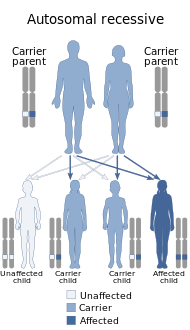| GRACILE syndrome | |
|---|---|
| Other names | Growth delay-aminoaciduria-cholestasis-iron overload-lactic acidosis-early death (GRACILE) syndrome, Finnish lethal neonatal metabolic syndrome (FLNMS), lactic acidosis, Finnish, with hepatic hemosiderosis, Fellman syndrome |
 | |
| This condition is inherited in an autosomal recessive manner. | |
GRACILE syndrome is a very rare lethal autosomal recessive genetic disorder, one of the Finnish heritage diseases. GRACILE syndrome has also been found in the UK and Sweden, but not nearly as much as in Finland.[1] It is caused by a mutation in the BCS1L gene and it occurs in approximately 1 out of 50,000 live births in Finnish people. To date, there have only been 32 cases of GRACILE syndrome reported. [2]
GRACILE is an acronym for growth retardation, aminoaciduria (amino acids in the urine), cholestasis, iron overload, lactic acidosis and early death. Prior to birth, the growth of the fetus is abnormally slow. This slow growth leads to a smaller than average newborn that has difficulty growing at a normal rate.[3]
- ^ "Orphanet: GRACILE%20syndrome". www.orpha.net.
- ^ Visapää I, Fellman V, Vesa J, Dasvarma A, Hutton JL, Kumar V, Payne GS, Makarow M, Van Coster R, Taylor RW, Turnbull DM, Suomalainen A, Peltonen L (October 2002). "GRACILE syndrome, a lethal metabolic disorder with iron overload, is caused by a point mutation in BCS1L". Am. J. Hum. Genet. 71 (4): 863–76. doi:10.1086/342773. PMC 378542. PMID 12215968.
- ^ Cite error: The named reference
:0was invoked but never defined (see the help page).